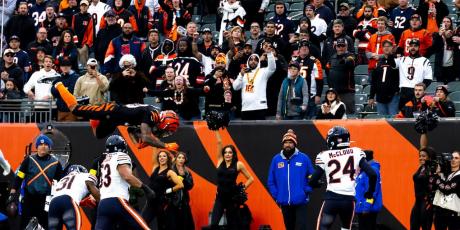Fantasy Football Salary Cap Draft Nomination Strategies

If you've been following along on our 2025 salary cap draft journey, I appreciate you, and welcome back! If you're new here, check out my mock draft breakdown and the massive tips and tricks guide published earlier this month.
Now, we're going to hone in on a unique aspect of salary cap draft strategy to give you a deeper edge once that clock starts. Though it may seem superfluous on the surface, the player nomination process — particularly the who and when — is a key cog in the complex machine of salary cap drafts. Your approach to player nominations can dictate when and where your budget and the budgets of your opponents are spent ... and can create constructive chaos if wielded correctly.
Let's dive into the various strategies worth considering on the nomination hot seat and when they'll have the biggest impact on your draft.
More Salary Cap Content: How to Dominate 2025 Salary Cap Drafts (Tips & Tricks) | Analyzing a 2025 Salary Cap Mock Draft (July)

DraftKings is giving ALL customers a can't-miss offer for Best Ball: Draft One, Get One! Enter a lineup in the $15 Million Best Ball Contest for just $20, and you'll score another Best Ball ticket to play FREE for a share of $15 million—giving you a second shot to win big!
Early Rounds
Information Acquisition
In the Tips & Tricks article, I emphasized the importance of both knowing player values and knowing when to ditch those values for new ones. The only way to make those active adjustments accurately is to critically observe and evaluate your league on the fly. And the best way to do that is by nominating the players and positions most likely to reveal tendencies early in the draft.
This approach can take a variety of forms.
- Nominate a top-tier running back and wide receiver in the first two rounds and compare the resulting bidding wars to get a sense of positional priority.
- Nominate a QB1 (or a couple) early on to see whether your league intends to battle for the best or save salary space. Do this with a high-end quarterback that you'd be happy drafting at a discount, just in case.
- Nominate a couple of rookies to gauge how sharp your opponents are on the 2024 draft class. Ashton Jeanty is an easy name for this strategy, but guys like RJ Harvey and Matthew Golden might reveal even more information.
- On the flip side, nominate a couple of less flashy "oldies" to judge your league's penchant for the "shiny, new toy." James Conner and Davante Adams are good examples of veterans who could become values in certain leagues.
There are many more, but the concept is simple: each nomination you make early on should teach you something about your opponents, whether you end up drafting the player or not.
The Best of the Busts
For the first several nominations, lean heavily towards players with high average values and significant hype ... that you don't like. Bid a few times to maintain appearances, but eventually abandon the helm and watch your league mates blast away their bankrolls fighting over players you have no interest in drafting. Not only do you deplete your opponents' salary space (setting yourself up for easier buys in the future), but you also delay the players you want into the middle rounds, when discounts are easier to find.
As I mentioned in the Tips & Tricks article, you can find "good" players to insert into this strategy by looking for the guys higher in ADP than in our 4for4 rankings. Tyreek Hill and T.J. Hockenson are a couple of examples based on that approach (although I personally like Hock). But feel free to use your own rankings for this as well. I, for one, don't love Baker Mayfield, James Cook, Garrett Wilson, or Sam LaPorta as much as average value would indicate and will happily encourage my league mates to blow their budgets acquiring them.
Don't Dry Your Tiers
As awful as my "tiers" pun may be, this approach is crucial to avoid the mistake of "over-patience" in salary cap drafts. If you're targeting a specific player (or group of players), you must nominate them before they're the last one(s) left in their tier. Why? Simple economics.
As with many of the nuances of salary cap drafts, this is about supply and demand. As a particular tier begins to dry up, the players in that tier become more attractive and more "necessary" in the eyes of many drafters. If Lamar Jackson, Josh Allen, Jalen Hurts, and Jayden Daniels are all gone, most everyone in the league knows Joe Burrow is the last chance at one of those "elite five" at the QB position. If you were intent on grabbing one, you're now likely to pay more for Burrow than you would have if you took him earlier in the tier.
Other notable tiers include the "overall RB1 candidates" that end around Breece Hall at RB13, the "clear WR1s" that end between A.J. Brown and Ladd McConkey in the second round, and the "elite tight ends" that quickly disappear after Brock Bowers, Trey McBride, and George Kittle. That said, tiers extend throughout the entirety of drafts, murky though they may be in later rounds. Try to organize your own personal tiers before your draft, and make sure to manage your nominations accordingly.
Middle Rounds
Defenses and Kickers
You read that right. Defenses and kickers are here in the "middle rounds" section ... though in fairness, this approach works throughout the entire draft. Importantly, this should only be a strong consideration if your league requires you to draft these positions; otherwise, the better play is often to draft a potential training camp breakout and drop them for your kicker/defense before Week 1.
Unlike in snake drafts, where being the first manager to take a defense or a kicker opens you up to ridicule, salary cap drafts can be an excellent opportunity to go for the elite defenses and kickers early on. The reason this strategy works here is that by nominating the best of the best for $1, you get a win-win proposition: either someone outbids you (spending extra budget on a less important position) or you sneak a Brandon Aubrey or Broncos D/ST for the absolute minimum. I don't mind doing this on repeat until, inevitably, the league lets me have a solid kicker and defense for pennies. As I mentioned, this strategy can work anywhere in the draft process, but it's likely to work earlier on when managers are hoarding their budget for "critical" target players.
Positional Leverage
This is one of the easiest nomination strategies to execute and can be one of the most valuable through the meat of your draft. Quite simply, as soon as you're confident in your team's build at a position, start hammering that position with your nominations. Did you pick up an elite quarterback early on? Nominate QB1s until the rest of your league has paid their QB tax. Did you manage to pick up CeeDee Lamb, Drake London, and Marvin Harrison Jr. through the first few rounds? Throw up the top available wide receivers for the next several.
Similar to the "Best of the Busts" approach, using this positional leverage has a twofold benefit. For starters, you're continuing to deplete opponent bankrolls with safe nominations that you'd have no regrets "losing." Simultaneously, you're continuing to push the players you do need down the draft board, into discount territory. This parleys perfectly into the next approach ...
Don't Be Obvious
We touched on this nomination strategy in the Tips & Tricks article, and once again, it's pretty simple: don't be obvious about your favorite value picks. In other words ... don't nominate them. Here in the middle rounds, nominations typically trend from the objective "best on the board" to the names that stand out subjectively to each individual manager. If you follow this tendency and nominate the players that catch your eye, your opponents will likely recognize your interest and run up the price.
Instead, let someone else nominate the players you're targeting and then fight for value once they're on the clock. This approach is best applied to players ranging from roughly $5-$25 in expected value (with a $200 budget), not to your deepest sleepers. Of course, you'll need to be prepared for the nominating manager to bid for your player (by the same logic that governs this strategy in the first place), so remember to track their budget and leverage yours accordingly.
Friendly Fire
If you followed the "Know Your League" tip from the Tips & Tricks piece, this nomination strategy becomes particularly valuable in the middle rounds. Start playing offense by making nominations targeted at specific managers — particularly the ones with hefty remaining budgets. If they have one half of a valuable QB-receiver stack, nominate the other half. If they've punted on running back and a great zero-RB target is still on the board, nominate that back. If they're a diehard Browns fan and don't have a tight end, send your condolences, and then nominate David Njoku. If you know their favorite sleeper, throw them out early to force a bidding war. You get the idea.
Some portion of salary cap nomination strategy is assembling your own roster for the best possible value. But perhaps the majority of your approach should focus on filling your opponents' rosters and depleting their budgets, to leave you with the clearest (and cheapest) path to the players you want. Don't be afraid to get your hands dirty and stir up some conflict. Salary cap drafts are the battlefields of fantasy acumen, and it takes some aggression to come out on top.
Late Rounds
Get Your Guys
The later rounds — when pricing drops into the low single digits — are for one thing and one thing only: stocking up your sleepers. You should be using the back quarter of your draft to nominate the players you want on your bench, and ideally, navigating the max bids and remaining budgets of your league mates to land those players successfully.
Notably, this is also the one area of the draft where it can be viable and even profitable to nominate players for more than a single dollar. Keep a close eye on your opponents' salary space. If they're down to a maximum bid of $2 and you suspect they might have interest in your sleeper, nominating that player for $2 instead of $1 guarantees you get him.


















